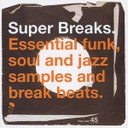TRACKLIST
A1 –Soul Children Intro (Spoken Word)
A2 –Isaac Hayes Ike's Mood
A3 –Jackie Wilson Light My Fire
A4 –Syl Johnson Different Strokes
A5 –The Counts Thinking Single
A6 –The Emotions Blind Alley
B1 –Camille Yarbrough Take Yo' Praise
B2 –Linda Lyndell What A Man
B3 –Lowell Fulson Tramp
B4 –Googie Rene Combo Smokey Joe's La La
B5 –Jean Jacques Perrey* E.V.A.
C1 –The Blackbyrds Rock Creek Park
C2 –Fatback Band* Got To Learn How To Dance
C3 –Pleasure (4) Bouncy Lady
C4 –Joe Simon Drowning In The Sea Of Love
D1 –Cannonball Adderley Walk Tall
D2 –S.O.U.L. Burning Spear
D3 –The Otis And Carla Band Tramp (Instrumental)
D4 –The Pazant Bros* Chick A Boom
D5 –The Detroit Emeralds* Baby Let Me Take You (In My Arms)
DESCRIPTION
In the 20 years since hip hop culture broke over-ground with the arrival of the Fatback Band's King Tim III and the massive international success of the Sugarhill Gang's Rapper's Delight, rap music has moved to becoming the premier sales arm of the US record industry. And yet up until that point the culture that had emerged in the Bronx and then spread to other black areas of New York had only been visible to the rest of the city as the graffiti on the sides of the Subway trains that criss-crossed the five boroughs.
Hip hop was a reaction to and a mirror of the prevailing elitist disco culture that was beginning to dominate mainstream New York club life in the early 70s, effectively excluding the large black working class with high door charges. In the Bronx this led to the organisation of block parties run in the area by local entrepreneurs in parks and on street corners - often using electricity purloined from the nearest lamppost. These local sound systems were particularly prevalent in the Bronx and the biggest and best was run by a Jamaican ?©migr?© DJ Kool Herc. Herc had initially tried to play reggae but found that there was no real taste for it in the Bronx and shifted to playing Latin-tinged funk. This proved more popular but he hit pay dirt when he took to just playing the record's breakdown or break- taking two copies of the record and shifting from deck to deck repeating this most exciting part of the record to drive the crowd wild. He had also created one of the most important tools of modern record production.
For some time this hardly seemed credible, others such as Afrika Bambaattaa, Grand Wizard Theodore and Grandmaster Flash followed his lead creating new techniques and building the nascent hip hop movement into something special in black New York. As early as 1976 Flash could attract 3,000 people to shows he was putting on, and DJs guarded their discoveries as seriously as Northern Soul DJs in the UK covering up or scraping off the labels. But without music industry contacts there was no way out to a wider audience. When the breakthrough came the break - which had always been the most important part of the culture - was suddenly hidden. The records that were made focussed on the MCs who had accompanied the DJ stars and they were renamed rappers and became the stars. Technology didn't allow the break to feature in records - give or take a few notable exceptions - and by the mid 80s it looked like this part of hip hop culture might be about to die out.
The whole scenario changed with the arrival of the Akai sample. This made it an affordable option for the DJ to loop up his records behind the rapper - and soon a new school of hip hop had emerged with music totally based on the break. Hip hop was totally rejuvenated and from the mid 80s entered a golden age where the likes of Public Enemy, De La Soul, Run DMC, the Jungle Brothers, A Tribe Called Quest and Marley Marl's Cold Chillin' label released awe-inspiring records built on a mind boggling array of samples.
Super Breaks is the first of BGP's delve into the murky world of the break (though compiler Dean Rudland has previously originated Blue Note's highly successful Blue Breaks' series) and rounds up breaks used by artists such as Gangstarr, Mary J Blige, De La Soul and Will Smith by artists from the very obscure to soul's premier league. We have included one of this year's most successful breaks - Camille Yarbrough's Take Yo' Praise better known from Fatboy Slim's Praise You number one hit. Most important of all Super Breaks remembers the contributions of the early pioneers whose work and innovations mean that a sample is just as likely to be used on a new Madonna or Verve record as on the latest by the Wu Tang Clan.
By Aaron Slowley







